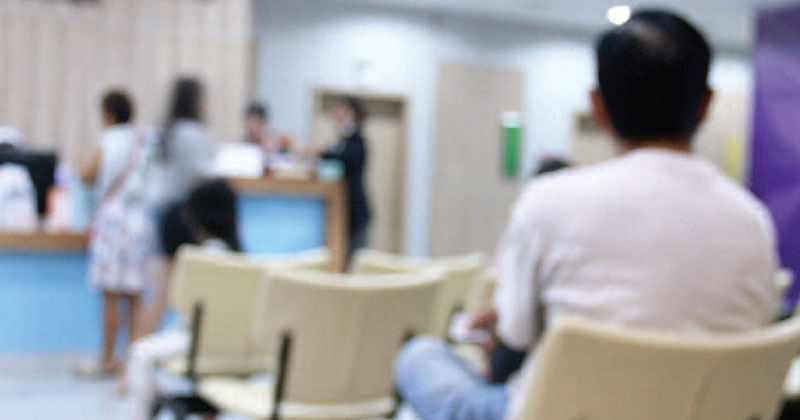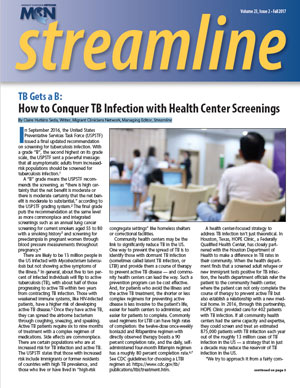TB Gets a B: How to Conquer TB Infection with Health Center Screenings

By Claire Hutkins Seda, Writer, Migrant Clinicians Network, Managing Editor, Streamline
In September 2016, the United States Preventative Services Task Force (USPSTF) issued a final updated recommendation on screening for tuberculosis infection. With a grade “B”, the second highest on its grade scale, the USPSTF sent a powerful message: that all asymptomatic adults from increased risk populations should be screened for tuberculosis infection.1
A “B” grade means the USPSTF recommends the screening, as “there is high certainty that the net benefit is moderate or there is moderate certainty that the net benefit is moderate to substantial,” according to the USPSTF grading system.2 The final grade puts the recommendation at the same level as more commonplace and integrated screenings such as an annual lung cancer screening for current smokers aged 55 to 80 with a smoking history3 and screening for preeclampsia in pregnant women through blood pressure measurements throughout pregnancy.4
There are likely to be 13 million people in the US infected with Mycobacterium tuberculosis but not showing active symptoms of the illness.5 In general, about five to ten percent of infected individuals will flip to active tuberculosis (TB), with about half of those progressing to active TB within two years from contracting TB infection. Those with weakened immune systems, like HIV-infected patients, have a higher risk of developing active TB disease.5 Once they have active TB, they can spread the airborne bacterium through coughing, sneezing, and speaking. Active TB patients require six to nine months of treatment with a complex regimen of medications. Side effects are commonplace. There are certain populations who are at increased risk for TB infection and active TB. The USPSTF states that those with increased risk include immigrants or former residents of countries with high TB prevalence, and those who live or have lived in “high-risk congregate settings” like homeless shelters or correctional facilities.
Community health centers may be the link to significantly reduce TB in the US. One way to prevent the spread of TB is to identify those with dormant TB infection (sometimes called latent TB infection, or LTBI) and provide them a course of therapy to prevent active TB disease — and community health centers can lead the way. Such a prevention program can be cost effective. And, for patients who avoid the illness and the active TB treatment, the shorter or less complex regimens for preventing active disease is less invasive to the patient’s life, easier for health centers to administer, and easier for patients to complete. Commonly used regimens for LTBI can have high rates of completion: the twelve-dose once-weekly Isoniazid and Rifapentine regimen with directly observed therapy boasts a 90 percent completion rate, and the daily, self administered four-month Rifampin regimen has a roughly 80 percent completion rate.6,7 See CDC guidelines for choosing a LTBI regimen at: https://www.cdc.gov/tb/publications/ltbi/treatment.htm.
A health center-focused strategy to address TB infection isn’t just theoretical. In Houston, Texas, HOPE Clinic, a Federally Qualified Health Center, has closely partnered with the Houston Department of Health to make a difference in TB rates in their community. When the health department finds that a screened adult refugee or new immigrant tests positive for TB infection, the health department officials refer the patient to the community health center, where the patient can not only complete the course of therapy to prevent active TB but also establish a relationship with a new medical home. In 2016, through this partnership, HOPE Clinic provided care for 402 patients with TB infection. If all community health centers had the same capacity and expertise, they could screen and treat an estimated 875,000 patients with TB infection each year out of the roughly 13 million cases of TB infection in the US — a strategy that in just a decade may reduce the reservoir of TB infection in the US.
“We try to approach it from a fairly comprehensive perspective,” noted Kara Green, FNP, Director of Clinical Services and Continuous Quality Improvements at HOPE Clinic. “Sometimes patients [think] we’re just here for vaccines or active TB disease, but we say that we’re your family’s doctors and we take care of all your medical needs, and one part of that is this latent TB. I think it helps that we see other patients at the same time for diabetes, hypertension, back pain.”
With the mission to provide care to medically underserved populations, community health centers like HOPE Clinic are in a unique position to take a sizeable step toward TB elimination in the US. In 2016, roughly 68 percent of active TB cases in the US were among foreign born people and 90 percent of TB cases in foreign-born patients were attributable to reactivation of prior, latent tuberculosis infection.8 Given that health centers’ patient populations are ethnically diverse, with roughly 62 percent of patients identifying as a “racial and/or ethnic minority” and almost 23 percent feeling they are best served in a language other than English.9,10 their patient populations are likely to have a higher prevalence of TB infection.
“Some clinics don’t have capacity or comfort with this issue, but we’ve have good success so far,” Green said. As treatment innovations progress, health centers may find management of TB infection doable within their settings. For example, Green is excited about future innovations, like shorter treatment durations and directly observed therapy over live video chat, both of which promise to reduce costs and increase treatment completion rates — which can go a long way in eliminating TB in the US. She also recognizes that the health center approach is effective not just because of the provision of medications but the reach into the community to break down stigma and increase understanding of TB and TB infection.
“The education [of] one family goes a long way in their individual cultural communities, so that TB evaluation and treatment for LTBI or active disease becomes more normative,” Green said. With such a multifaceted approach, health centers can make strides toward TB elimination: “Any efforts we are able to accomplish here hopefully help impact the worldwide picture of TB.”
The CDC’s page on TB infection treatment is available at: https://www.cdc.gov/tb/publications/ltbi/treatment.htm
References
- US Preventative Services Task Force. Latent Tuberculosis Infection: Screening. Available at: https://www.uspreventiveservicestaskforce.org/Page/Document/UpdateSummaryFinal/latent-tuberculosis-infection-screening
- US Preventative Services Task Force. Grade Definitions. Available at: https://www.uspreventiveservicestaskforce.org/Page/Name/grade-definitions
- US Preventative Services Task Force. Lung Cancer: Screening. Available at: https://www.uspreventiveservicestaskforce.org/Page/Document/UpdateSummaryFinal/lung-cancer-screening
- US Preventative Services Task Force. Preeclampsia: Screening. Available at: https://www.uspreventiveservicestaskforce.org/Page/Document/UpdateSummaryFinal/preeclampsia-screening1?ds=1&s=preeclampsia
- Centers for Disease Control and Prevention. Tuberculosis (TB): Latent Tuberculosis Infection: A Guide for Primary Health Care Providers. Available at: https://www.cdc.gov/tb/publications/ltbi/intro.htm
- Sterling TR, Villarino ME, Borisov AS, et al; TB Trials Consortium PREVENT TB Study Team. Three months of rifapentine and isoniazid for latent tuberculosis infection. N Engl J Med. 2011;365(23): 2155-2166. Accessed June 7, 2017. Available at: http://www.nejm.org/doi/full/10.1056/NEJMoa1104875
- Menzies D, Long R, Trajman A, et al. Adverse events with 4 months of rifampin therapy or 9 months of isoniazid therapy for latent tuberculosis infection: a randomized trial. Ann Intern Med. 2008;149(10):689-97. Available at: https://www.ncbi.nlm.nih.gov/pubmed/19017587
- Schmit KM, Wansaula Z, Pratt R, Price SF, Langer AJ. Tuberculosis — United States, 2016. MMWR Morb Mortal Wkly Rep 2017;66:289–294. DOI: http://dx.doi.org/10.15585/mmwr.mm6611a2.
- Shin P, Alvarez C, Sharac J, Rosenbaum S, et al. A Profile of Community Health Center Patients: Implications for Policy. Henry J. Kaiser Family Foundation. 2013. Available at: http://www.kff.org/report-section/a-profile-of-community-health-center-patients-demographic-characteristics/
- 2016 Health Center Data: Health Resources and Services Administration, Health Center Program. Expanded Summary for 2016UDS Tables 3A-9E and EHR Information. Available at: https://bphc.hrsa.gov/uds/datacenter.aspx
Read this article in the Fall 2017 issue of Streamline here!
Sign up for our eNewsletter to receive bimonthly news from MCN, including announcements of the next Streamline.
